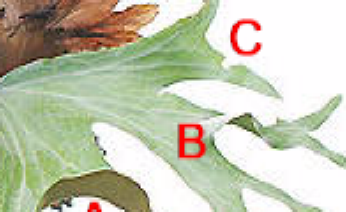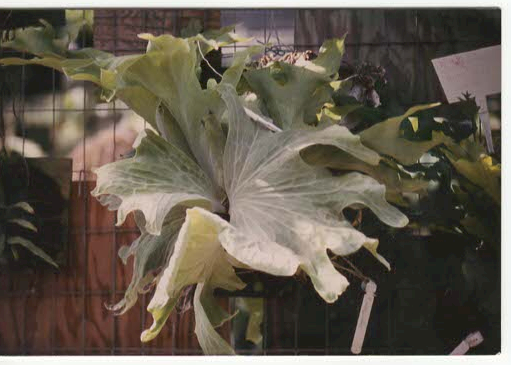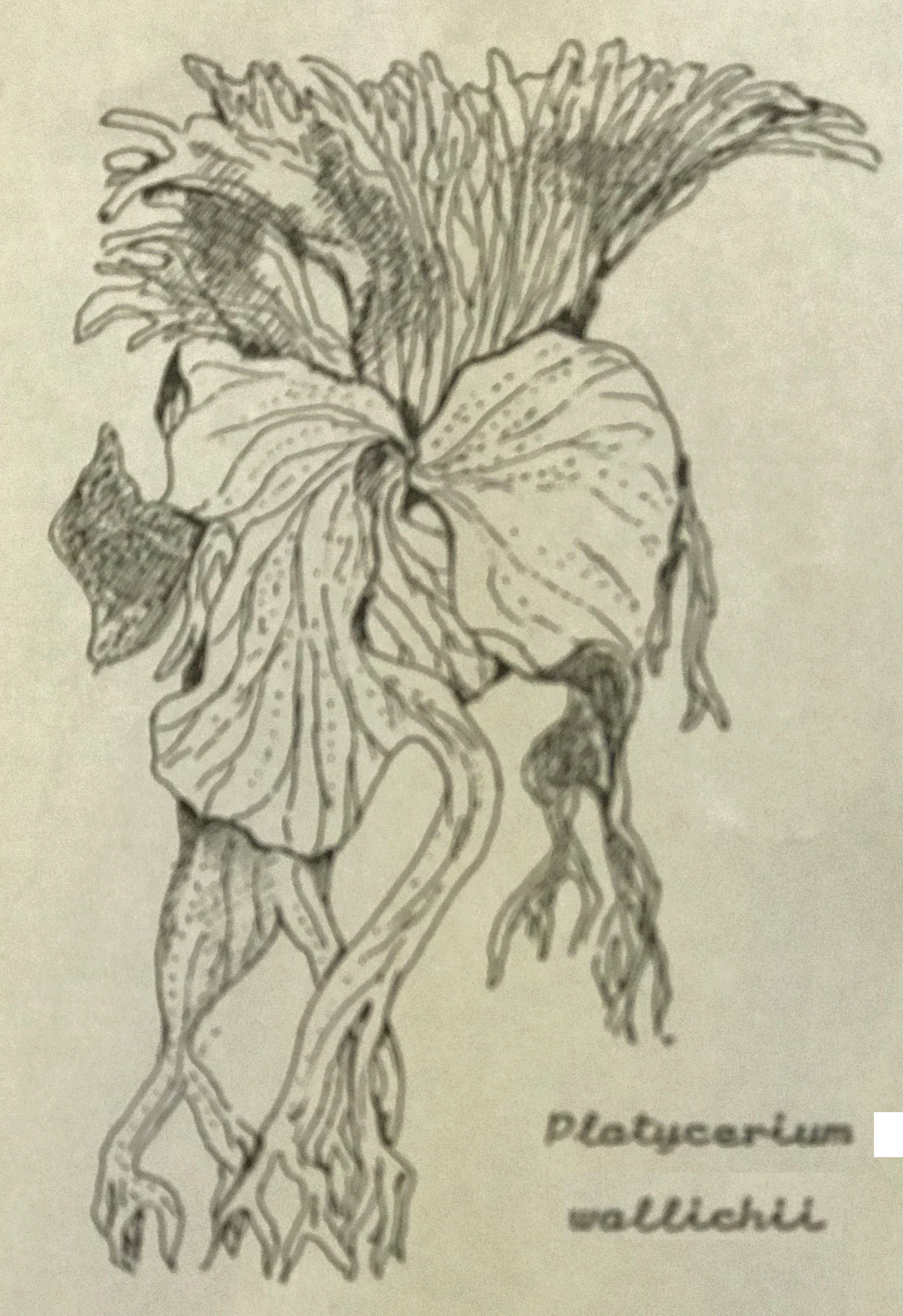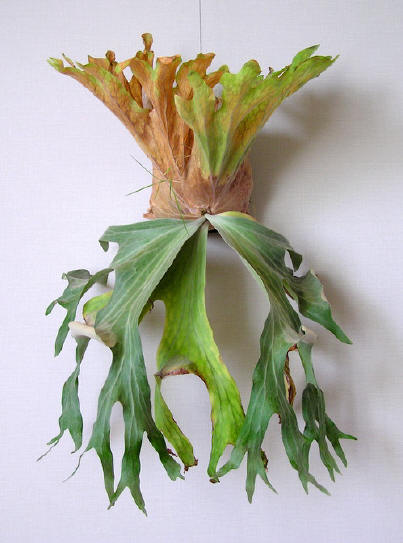|
The P. wallichii is named for Nathaniel Wallich, Director of
the Calcutta Botanical Garden in 1815 Common name is Indian
Staghorn, they are found in the wild in Thailand, Northern India,
Burma and the Yunnan Privince of China.
This species has tall
spreading shields with many rounded lobes along their upper edge.
It forms a definite basket. The shields may all be brown while
the fertile fronds are still green.
 The
fertile fronds have distinctively prominent veins on the upper side.
Their shape varies greatly in cultivation. Although there is one
main lobe which hangs down and has the main spore patch on in, there
may be a second lobe to it's side with a spore patch, with third lobe
to it's side with no spore patch. If there are enough lobes, the
frond becomes fan-like and the outer lobes may even blend in with the
shields. The area with the spore patch extends forward and may
have points on the edge. The three lobes are labeled A, B, C in
photo on right. This photo also shows blotched shield fronds
that no one has discussed in publications. Are they dirt stains
or typical markings on all P. wallichii? Observing Google
images suggests they may be common markings on P. wallichii. The
fertile fronds have distinctively prominent veins on the upper side.
Their shape varies greatly in cultivation. Although there is one
main lobe which hangs down and has the main spore patch on in, there
may be a second lobe to it's side with a spore patch, with third lobe
to it's side with no spore patch. If there are enough lobes, the
frond becomes fan-like and the outer lobes may even blend in with the
shields. The area with the spore patch extends forward and may
have points on the edge. The three lobes are labeled A, B, C in
photo on right. This photo also shows blotched shield fronds
that no one has discussed in publications. Are they dirt stains
or typical markings on all P. wallichii? Observing Google
images suggests they may be common markings on P. wallichii.
 Roy
Vail's photo on left shows a fertile frond with many lobes. Only
the first two have spore patches. This fertile frond is so wide
that it has formed a curtain in front of the shield fronds.
Notice the distinctively prominent veins on the upper side. Roy
Vail's photo on left shows a fertile frond with many lobes. Only
the first two have spore patches. This fertile frond is so wide
that it has formed a curtain in front of the shield fronds.
Notice the distinctively prominent veins on the upper side.
P. wallichii is difficult to grow in collections. It
may die from rots, but more often it goes into dormancy and never
comes out. There are different ideas on how to prevent dormancy.
One grower gives it no water while dormant. Another grower keeps
it watered well all year so it does not go dormant. More
experience with this species is needed and there are too few growers
of P. wallichii.
P. wallichii growing in Thailand grow together with P.
holttumii and share the same environment, monsoon forests with
definite wet and dry seasons. Roy Vail thinks possibly cool
temperatures during dormancy are important to these plants.
Roy feels the future of P. wallichii in the hobby probably
depends more on sporelings being raised under cultivation here than on
imports. These plants could be better conditioned to the
environment in collections. The spore are green, an indication
they do not live long. They germinate quickly. Sporelings,
under very moist conditions, have volunteered, causing Roy to suggest
that a pad of moist moss kept below a spore patch might develop some
sporelings.
| Comparison of; P. grande, P. superbum,
P. holttumii, P. wandae, P. wallichii |
|
Species |
P. grande |
P. superbum |
P. holttumii |
P. wallichii |
P. wandae |
| Common Name |
Grande |
Superbum |
Holttumii |
Indian
Staghorn |
Queen Staghorn |
| Temp Range |
40 to 100 F |
30 to 100 F |
60 to 100 F * |
60 to 100 F * |
60 to 100 F * |
| Number of fertile fronds with lobes |
Many, divided |
Many,
not divided |
Many with 2 lobes
1 elevated,
1 hanging down |
Many with only 2 lobes |
Many with 2 lobes
1 elevated,
1 hanging down |
| No. Spore Patches |
Two per Lobe |
One per lobe |
One per lobe |
One per lobe |
One per lobe |
| Spore Patch shape |
Equal size |
Oval/triangular |
1 small elevated
1 large hanging down |
Not known |
1 small elevated
1 large hanging down |
| Frill around bud |
No |
Yes |
No |
No |
Yes |
| Volunteer Pups |
No |
No |
No |
Very rare** |
No |
| Native to: |
Philippines |
Australia |
SE Asia |
SE Asia |
New Guinea |
So. California
Growing environment |
Humid greenhouse |
Outside
50% shade cloth |
Humid
Greenhouse |
Humid
Greenhouse |
Humid
Greenhouse |
|


 The
fertile fronds have distinctively prominent veins on the upper side.
Their shape varies greatly in cultivation. Although there is one
main lobe which hangs down and has the main spore patch on in, there
may be a second lobe to it's side with a spore patch, with third lobe
to it's side with no spore patch. If there are enough lobes, the
frond becomes fan-like and the outer lobes may even blend in with the
shields. The area with the spore patch extends forward and may
have points on the edge. The three lobes are labeled A, B, C in
photo on right. This photo also shows blotched shield fronds
that no one has discussed in publications. Are they dirt stains
or typical markings on all P. wallichii? Observing Google
images suggests they may be common markings on P. wallichii.
The
fertile fronds have distinctively prominent veins on the upper side.
Their shape varies greatly in cultivation. Although there is one
main lobe which hangs down and has the main spore patch on in, there
may be a second lobe to it's side with a spore patch, with third lobe
to it's side with no spore patch. If there are enough lobes, the
frond becomes fan-like and the outer lobes may even blend in with the
shields. The area with the spore patch extends forward and may
have points on the edge. The three lobes are labeled A, B, C in
photo on right. This photo also shows blotched shield fronds
that no one has discussed in publications. Are they dirt stains
or typical markings on all P. wallichii? Observing Google
images suggests they may be common markings on P. wallichii. Roy
Vail's photo on left shows a fertile frond with many lobes. Only
the first two have spore patches. This fertile frond is so wide
that it has formed a curtain in front of the shield fronds.
Notice the distinctively prominent veins on the upper side.
Roy
Vail's photo on left shows a fertile frond with many lobes. Only
the first two have spore patches. This fertile frond is so wide
that it has formed a curtain in front of the shield fronds.
Notice the distinctively prominent veins on the upper side.